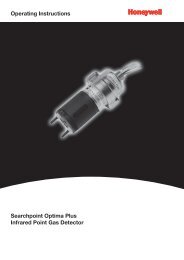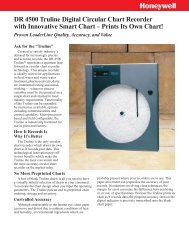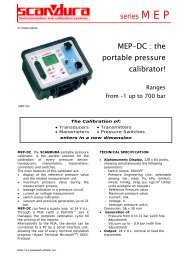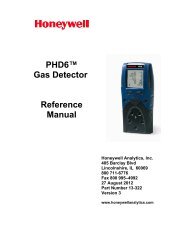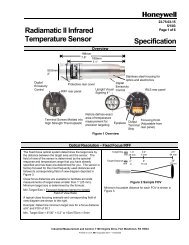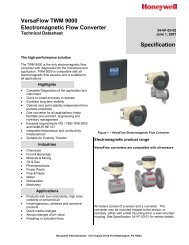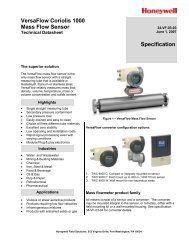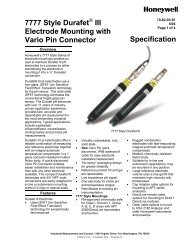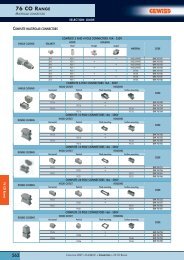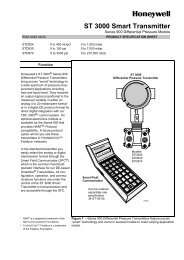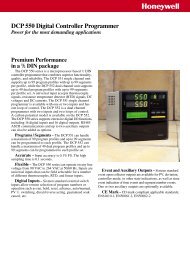Specification Sheet
Specification Sheet
Specification Sheet
You also want an ePaper? Increase the reach of your titles
YUMPU automatically turns print PDFs into web optimized ePapers that Google loves.
70-82-03-04Page 2The fouling-resistant referenceelectrodes are filled with a longlastingKCI slurry or a viscous KCIgel that eliminates maintenance forthe life of the electrode. (The latterare recommended for generalpurposeuse, especially forapplications involving severecontamination, temperature orpressure cycling, continuous hightemperatures, or dry periods.) TheRyton-body electrode is virtuallyunbreakable and has an easilyreplaced porous-plug junction, theglass electrode has the porousplug sealed into the tube, and thecap and internal element isremovable for maintenance.Automatic temperaturecompensators correct for themeasuring electrode temperaturecoefficient. With microprocessorbasedinstruments they can alsocorrect for the change in ionizationof pure water samples, providingsolution temperaturecompensation to 25°C.Temperature compensation is notused in ORP systems.A Meredian combinationmeasuring/reference electrode,with or without temperaturecompensator reduces the numberof housings installed in theprocess. The integral temperaturecompensator is housed in theupper part of 31050381 and31055546 Meredian electrodesand is not in close contact withprocess conditions. If temperatureextremes occur and compensationis critical, a separately mountedcompensator is preferred.PreamplifierThe preamplifier conditions theMeredian electrode signal locally toa low impedance signal that canthen be sent over ordinaryunshielded wire to the Honeywellanalyzer, recorder, or transmitter.The preamplifier system has highimmunity to RF noise. The uniquegeometry of the electrode designprovides the means to obtainaccurate, continuousmeasurements in the presence ofstreaming potentials or high solutioncurrents in electrolytic processes.The 7758 Assembly can include apreamplifier module in a NEMA 4Xenclosure for mounting within 10’ ofMeredian electrodes.Another preamplifier option is anenvironmentally sealed(encapsulated) high-impedanceamplifier to which the Durafet II orMeredian combination electrode isdirectly connected. Thesepreamplifiers feature Honeywell’squick-disconnect plug, allowing easyinstallation of the electrode using notools. A second quick-disconnectplug permits removal of thepreamplifier for troubleshooting orroutine maintenance.Durafet II Adaptor ModuleTo use a Durafet II electrode withother than Honeywell instruments,an adaptor module is available. Itprovides a temperaturecompensated pH signal to theconventional electrode input ofmeasuring instruments other thanHoneywell. Temperaturecompensation must be fixed at25°C on the instrument. Alsoavailable is the new batterypoweredinterface module. P/N075773.Special ApplicationsFor high purity waterThe 7758-5-8-40-8 low volume flowchamber option produces a highflowvelocity with a low 100-200m/L/min sample flowrate. In powerplant samples that may contain ironoxide and other solids, the highvelocity carries them through andprevents them from accumulatingand slowing electrode response.This option also provides a solutionground circuit that stabilizes themeasurement.For sterilizable processesThe mountings can be used forprocesses with a maximumtemperature of 130°C (266°F).Typical applications for thesesterilizable processes arefermenters, and the food and drugindustries. For single-probesterilizable applications, the 117494Meredian Electrode is used; specify“50” in Table III.Pressure andTemperature LimitsFlow RateElectrical ConnectionsMounting Configuration<strong>Specification</strong>s316 Stainless steel wetted parts: 1034 kPa at 100°C (150 psig at 212°F); 345 kPa at130°C (50 psig at 226°F)Polypropylene wetted parts: 689 kPa at 35°C (100 psig at 95°F); 345 kPa at 75°C(50 psig at 167°F). Also see electrode specs.Recommended velocity of clear solutions, 0.3 - 3 m/s (1 - 10 ft/s). For more viscous or abrasivesolutions, recommended velocity is 0.3 - 1.5 m/s (1 - 5 ft/s).Glass Electrodes: 12-ft tinned leads from sensors to pramplifiers.Durafet II Electrodes: Up to 50 ft. quick disconnect cable from sensor to preamplifier.When more than one housing is used, they should be as close as possible. Suggested sequenceto direction of flow, reference electrode, measuring electrode and temperature compensator.



